|
Nobel Laureate Pierre-Gilles de Gennes Dies at 74
 French physicist Pierre-Gilles de Gennes, who won the 1991 Nobel Prize in Physics for "discovering that methods developed for studying order phenomena in simple systems can be generalized to more complex forms of matter, in particular to liquid crystals and polymer," has passed away. He was 74. Professor de Gennes was a pioneer of the Liquid Crystal Display (LCD), which is widely used in today's consumer electronics. His research focused initially on neutron scattering and magnetism, and it was in the 60s that he ventured into the realm of supraconductors and later of liquid crystals. French physicist Pierre-Gilles de Gennes, who won the 1991 Nobel Prize in Physics for "discovering that methods developed for studying order phenomena in simple systems can be generalized to more complex forms of matter, in particular to liquid crystals and polymer," has passed away. He was 74. Professor de Gennes was a pioneer of the Liquid Crystal Display (LCD), which is widely used in today's consumer electronics. His research focused initially on neutron scattering and magnetism, and it was in the 60s that he ventured into the realm of supraconductors and later of liquid crystals.
Born in 1932, de Gennes graduated from the elite Ecole Normale Superieure. From 1955 to 1959, he was a Research Engineer at the Atomic Energy Center (Saclay), working mainly on neutron scattering and magnetism, with advice from A. Herpin, A. Abragam and J. Friedel (PhD 1957). In 1959, he was a Postdoctoral Visitor with C. Kittel at Berkeley. In 1961, he became Assistant Professor in Orsay and soon started the Orsay group on supraconductors. In 1971, he became Professor at the College de France, and was a participant of STRASACOL (a joint action of Strasbourg, Saclay and College de France) on polymer physics.
De Gennes had an interest in many other fields, rounding up his career at the Institut Curie medical laboratory in Paris, where he worked on cellular adhesion and brain function.
He was the author of two bestselling World Scientific titles, Petite Point, and Simple Views on Condensed Matter (3rd Edition).
|


